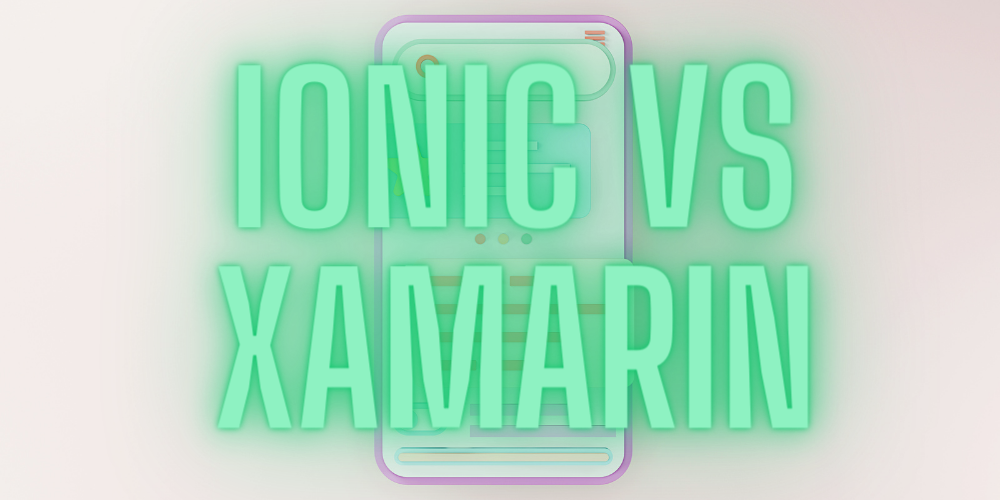Ionic and Xamarin are two popular frameworks for developing cross-platform mobile applications. Both frameworks allow developers to create apps for multiple platforms using a single codebase, but they differ in their programming languages, access to native device features, cost, and performance.
Ionic and Xamarin Overview
Xamarin-
Xamarin is a Microsoft-owned framework that allows developers to create mobile applications using C#. Xamarin provides a single codebase that can be used to build applications for both Android and iOS platforms. It also provides access to native device features through its libraries.
Xamarin provides a unique approach to cross-platform mobile application development. It allows developers to share a significant portion of their codebase between iOS, Android, and Windows platforms, reducing development time and costs. Xamarin also provides native user interfaces and access to native APIs, allowing developers to create high-performance, platform-specific mobile applications that provide a consistent user experience across devices.
Ionic-
Ionic is a popular open-source cross-platform mobile application development framework. It allows developers to build native-like mobile applications using web technologies such as HTML, CSS, and JavaScript. This article will provide an overview of the Ionic framework and its features.
Ionic is built on top of Angular, a popular web development framework that provides powerful tools for building complex web applications. This means that developers familiar with Angular can quickly get started with Ionic and take advantage of its pre-built UI components and features. However, developers unfamiliar with Angular can still use Ionic and take advantage of its extensive documentation and large community of developers.
Let’s talk about Ionic vs Xamarin from different perspectives-
1.Programming Language –
Ionic- The main programming language used in the Ionic framework is JavaScript and HTML and CSS for creating mobile applications. Ionic also uses the Angular framework to provide structure and components for building mobile apps.
Xamarin – Xamarin framework primarily uses C# as its programming language for developing mobile applications. Xamarin also provides its own set of APIs that allows developers to access native features on iOS, Android, and Windows platforms.
2.Installation-
Ionic- To install Ionic, you need to have Node.js and npm (Node Package Manager) installed on your machine. After that, you have just to install Ionic CLI.
Xamarin- To install Xamarin, you need to download and install Visual Studio, which is the integrated development environment (IDE) for building Xamarin apps.
3.Development Approach-
Ionic- Ionic provides a hybrid development approach that allows developers to build cross-platform mobile apps using web technologies.
Xamarin- Xamarin provides a native development approach that allows developers to build fully native apps for iOS, Android, and Windows platforms.
4.Tooling and Integration-
Ionic – The ionic framework has a command line interface CLI tools that simplifies the process of building, deploying, and testing mobile apps. It also includes features for live reloading and debugging.
Ionic has strong integration with Angular, a popular web development framework, and provides tools for integrating with other web technologies like React and Vue.js. Ionic also has good support for cloud services like Firebase, AWS, and Azure.
Xamarin- Xamarin, on the other hand, is integrated into Visual Studio, which provides a full-featured IDE for developing all kinds of applications, including Xamarin apps. Visual Studio includes features for debugging, profiling, and testing, as well as support for version control and collaboration.
Xamarin has strong integration with Microsoft technologies like Azure, Visual Studio, and .NET, as well as support for integrating with other cloud services like AWS and Salesforce.
5.Native Features And APIs-
Xamarin- Xamarin provides access to the full range of native features and APIs on each platform, including access to platform-specific features like 3D Touch, fingerprint authentication, and Siri integration on iOS.
Ionic- Ionic provides a set of UI components that are designed to look and feel like native components, but may not have access to all of the platform-specific features and APIs.
6.User Interface (UI)-
Ionic- Ionic uses web technologies to create the UI of the application, Ionic provides a set of UI components that are designed to look and feel like native components.
Xamarin- Xamarin uses the native UI component which means the applications look and feel like native applications.
7.Development Approach-
Ionic- Ionic provides a hybrid development approach that allows developers to build mobile apps using web technologies.
Xamarin- Xamarin provides a native development approach that allows developers to build fully native apps for each platform.
8.Performance-
Ionic – The performance of Ionic apps can vary depending on several factors, including the complexity of the app, the specific features and functionalities required, and the expertise of the development team. Ionic is generally not as fast as native mobile app development frameworks, such as Xamarin or React Native, due to its reliance on web technologies.
Xamarin – Xamarin is considered to have better performance than Ionic. This is because Xamarin uses compiled code and native UI components, which are optimized for each platform,
9.Documentation-
Ionic – Ionic documentation is known for its comprehensive and easy-to-understand format. Ionic has an active community forum and a well-documented GitHub repository, which developers can use to find solutions to common problems and ask for help from other community members.
Xamarin – Xamarin documentation is also comprehensive, with several resources available to developers, including getting started guides, tutorials, API references, and community forums.
Xamarin documentation can be more platform-specific, with separate documentation for iOS and Android, which can make it more challenging for developers to navigate.
10.Community Support-
Ionic – Ionic has a large and active community of developers, which is supported by the company behind the framework, the Ionic Framework Team.
Xamarin – Xamarin also has a large and active community of developers, which is supported by Microsoft, the company behind the framework. The community provides resources like forums, social media channels, and GitHub repositories. Additionally, Xamarin offers paid support packages, which include access to a dedicated support team, priority bug fixes, and more.
Conclusion-
Choosing a particular framework depends on your specific needs and preferences. In this article we talk about different factors about Ionic and Xamarin such as development skills, platform support, performance, resources, and community support. Keeping these points in mind you can easily choose a framework according to your use case.






Add comment